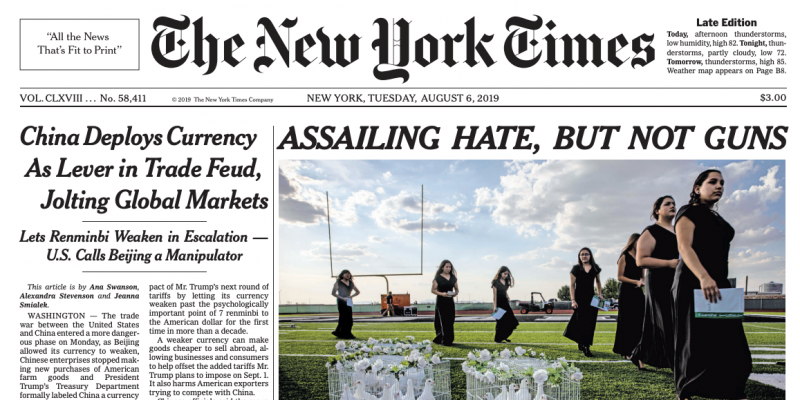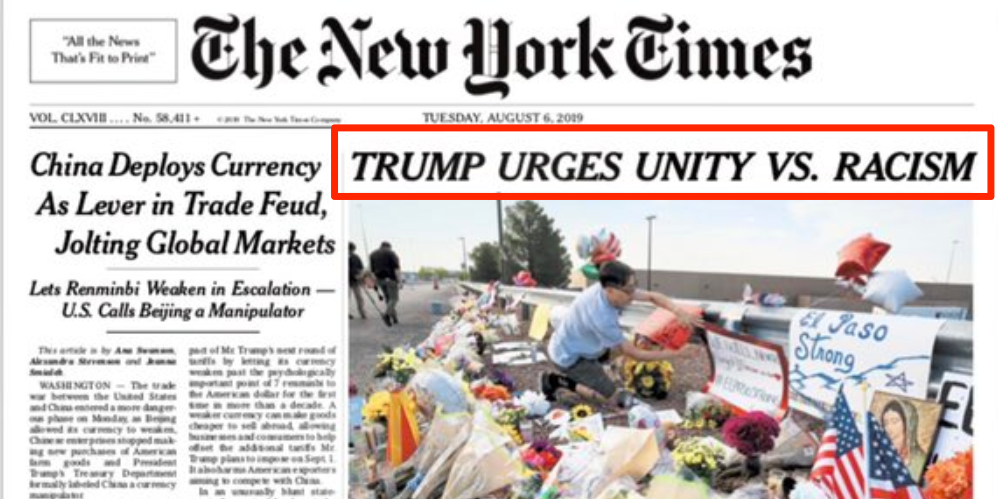- Democratic presidential candidates slammed The New York Times over an early characterization of President Donald Trump’s response to two mass shootings over the weekend.
- The first edition of the newspaper’s Tuesday issue had the headline “TRUMP URGES UNITY VS. RACISM,” which Beto O’Rourke called “unbelievable” and Alexandria Ocasio-Cortez described as “cowardice.”
- Much news coverage on Monday focused on Trump’s prevaricating response to the shootings, which saw him initially focus on mental health instead of addressing white supremacy.
- Trump’s response also saw him attempt to blame the media and use the shootings as an opportunity to advance his plans for immigration reform.
- The Times changed the headline for a later edition. The later headline was “ASSAILING HATE, BUT NOT GUNS.”
- “The original headline was flawed and was changed for all editions of the paper after the first edition,” The Times told Business Insider.
- Visit Business Insider’s homepage for more stories.
Democratic politicians criticized The New York Times over a front-page headline that gave a solely positive impression of President Donald Trump’s response to two mass shootings.
The most prominent headline on the first edition of the newspaper’s Tuesday front page said “TRUMP URGES UNITY VS. RACISM.”
Many, including 2020 presidential candidates and even New York Times writers, saw this as an inadequate summary of a fractious day in which Trump drew significant criticism over his response to the mass killings in El Paso, Texas, and Dayton, Ohio.
Trump’s initial response was to speculate about the mental health of the gunmen in both shootings. He further blamed the news media and suggested that the shootings provided a good prompt for immigration reform.
Many - including The Times - compared some of the language in Trump's past statements to that in an anti-immigrant screed the El Paso gunman is believed to have posted online ahead of the shooting. The Times article itself noted Trump was being criticized over the "plain echoes of his own language in the El Paso suspect's anti-immigrant manifesto."
Eventually, Trump did take a stand against white supremacy - the ideology that appears to have motivated the shooter in El Paso.
"In one voice, our nation must condemn racism, bigotry, and white supremacy," Trump told reporters in the White House.
After strong condemnation from Rep. Alexandria Ocasio-Cortez of New York and the presidential candidates Beto O'Rourke, Kirsten Gillibrand, and Bill de Blasio, the newspaper changed the headline to "ASSAILING HATE, BUT NOT GUNS" for its second edition.

O'Rourke, who previously represented El Paso in Congress, had called the original headline "Unbelievable."
Ocasio-Cortez retweeted an image of the front page with the comment: "Let this front page serve as a reminder of how white supremacy is aided by - and often relies upon - the cowardice of mainstream institutions."
Read more: The El Paso Walmart mass shooting claimed 22 victims. Here are their stories.
Sen. Cory Booker of New Jersey tweeted: "Lives literally depend on you doing better, NYT. Please do."
Gillibrand, a New York senator, tweeted: "That's not what happened."
De Blasio, the mayor of New York City, mentioned a Times advertising slogan in his criticism: "Hey, @nytimes - what happened to 'The Truth Is Worth It?'"
Trump has often appeared reluctant to condemn violence by white nationalists, notably blaming "both sides" after a man attending a white supremacist rally fatally struck a counterprotester with his car in Charlottesville, Virginia, in 2017.
Other prominent figures in US politics also weighed in on The Times' headline.
"Not sure 'TRUMP URGES UNITY VS. RACISM' is how I would have framed the story," Nate Silver, the editor-in-chief of FiveThirtyEight who previously worked under contract with The Times, tweeted.
The Times columnist Wajahat Ali also disapproved. "I write for the NYT," he tweeted. "This is a terrible headline."
The Times itself acknowledged problems with the headline, telling Business Insider: "The original headline was flawed and was changed for all editions of the paper after the first edition."

